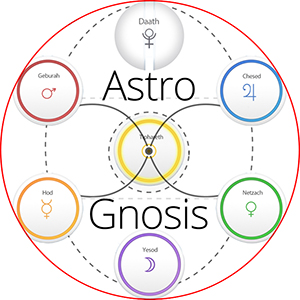In this article I wanted to explore the possible effects of a conjunction to one of the nodes in Capricorn and decided that a personal point such as the Sun or Moon might manifest most obviously in the life of an individual. I went with the Moon because it is representative of our most intrinsic needs. The idea with this line of research is to see how the combination of Moon and Descending Node Jupiter might combine in describing someone with an inherent need to respond to a sense of societal obligation, a sense of duty based upon a collective vision of truth or justice (being just one idea).
How might someone express their inner most Moon in Capricorn need for unadorned truth? Other phrases that come to mind are the need for emotional simplicity, honesty and integrity; an appreciation for the ‘hard-nosed’ reality of any situation; to create order from chaos (or at the very least, to contain chaos to prevent it from wreaking havoc in the world); a taciturn expression of the bare facts; or even a love of expressing a style stripped of emotional inference or affect; the structure of the psychic life; a container or vessel for inner emotional fulfilment without the need for outside interference – self-sustaining, self-satisfying emotional life; emotional resilience and austerity.
I’m experimenting with wider orbs here with the idea that the planetary nodes describe collective inference, like the bleeding of colour on a watercolour painting, rather than the bold and precise strokes of a coarse pallet knife.
George Washington – Moon Capricorn 9th conjunct SN Jupiter & SN Pluto square Pluto in Libra.
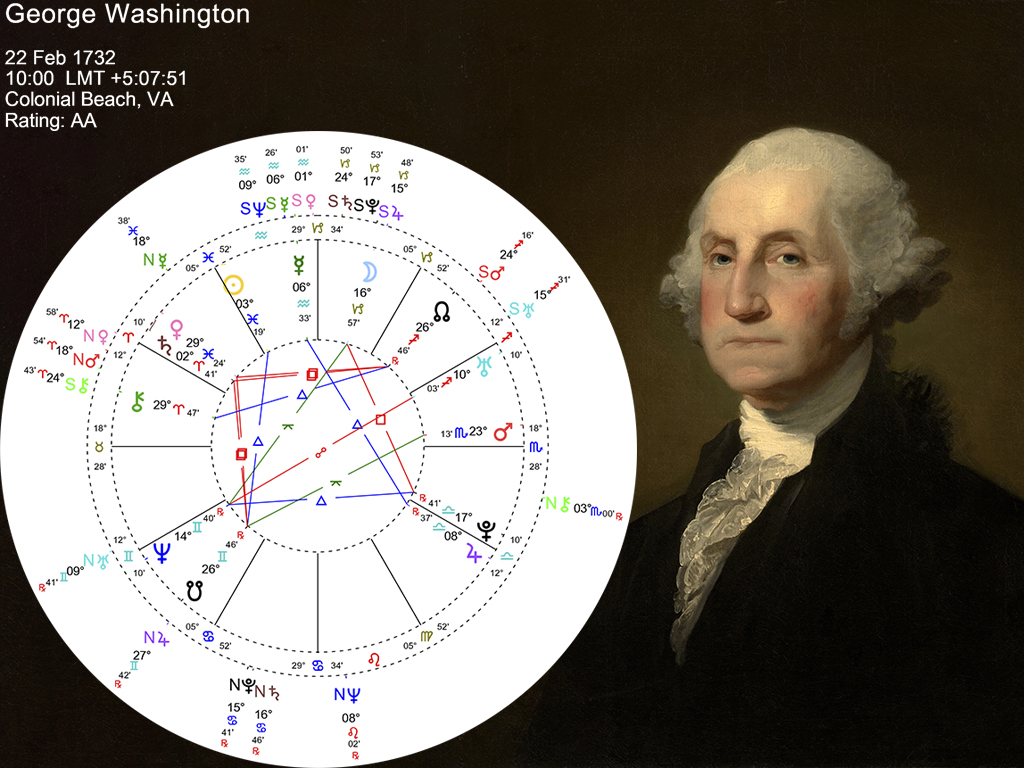
I don’t know enough about George Washington to be able to comment extensively about him. But I do know that the very focus of George Washington’s inner life was to bring social justice and structure through unity, if his much beloved United States was to survive. With his Moon conjunct the SN Jupiter, the Sagittarian concept of natural law shows something of Washington’s lifelong reluctance to accept political parties as a legitimate path for American governance, believing they would divide and destroy the young nation. His natal south node doubles up on this theme, being conjunct the Ascending Node of Jupiter.
In his Farewell Address in 1796 his ideas of the “the spirit of party…serves always to distract the public councils and enfeeble the public administration. It agitates the community with ill-founded jealousies and false alarms, kindles the animosity of one part against another, foments occasionally riot and insurrection.“
The centre of his power rested firmly on his ability to guide and rise above the conflicts between individual states, creating ‘an atmosphere that allowed convention members to reach the compromises necessary to create a bold, new government.
Gustave Courbet – Moon Capricorn 9th conjunct SN Jupiter and square to the Moon’s nodes.

With a similar placement to George Washington, the painter Gustave Courbet was the established leader of the Realism movement of 19th century French painting. Realists rejected Romanticism and revolted against the exotic subject matter that exaggerated emotionalism and drama. “Instead, it sought to portray real and typical contemporary people and situations with truth and accuracy, and not avoiding unpleasant or sordid aspects of life.”

This is surely a classic Moon Capricorn display of restrained emotionalism and delighting in the very real everydayness of committing to painting only that which he could see. As an innovator and an artist willing to make bold social statements through his work we can also see something of his square to the north node in Aries, amongst other aspects.
Alfred von Tirpitz – Moon Capricorn 12th conjunct SN Jupiter & SN Pluto square to Pluto and Uranus in Aries.

The man most responsible for building the modern German Navy, Tirpitz was Secretary of State for Naval Affairs from 1897-1910, a Grand Admiral in 1911, and a member of the Reichstag from 1924-28. He was sometimes referred to as “Tirpitz the Eternal,” because of his staying power in office. With his strong Moon in Capricorn square to Uranus and Pluto he painted an extreme figure taking unambiguous steps to further the ambitions of his nation. He often complained of the indecision and ambiguity in German policy and rejected ideas of German self-preservation. He called for vigorous warfare without regard for diplomatic and commercial consequences and supported the most extreme use of weapons, especially unrestricted submarine warfare.
Norman Rockwell – Moon Capricorn 2nd conjunct SN Jupiter & SN Pluto

Norman Rockwell was an American painter and illustrator whose “works have a broad popular appeal in the United States for their reflection of American culture.” Rockwell is most famous for the cover illustrations of everyday life he created for The Saturday Evening Post magazine over nearly five decades.
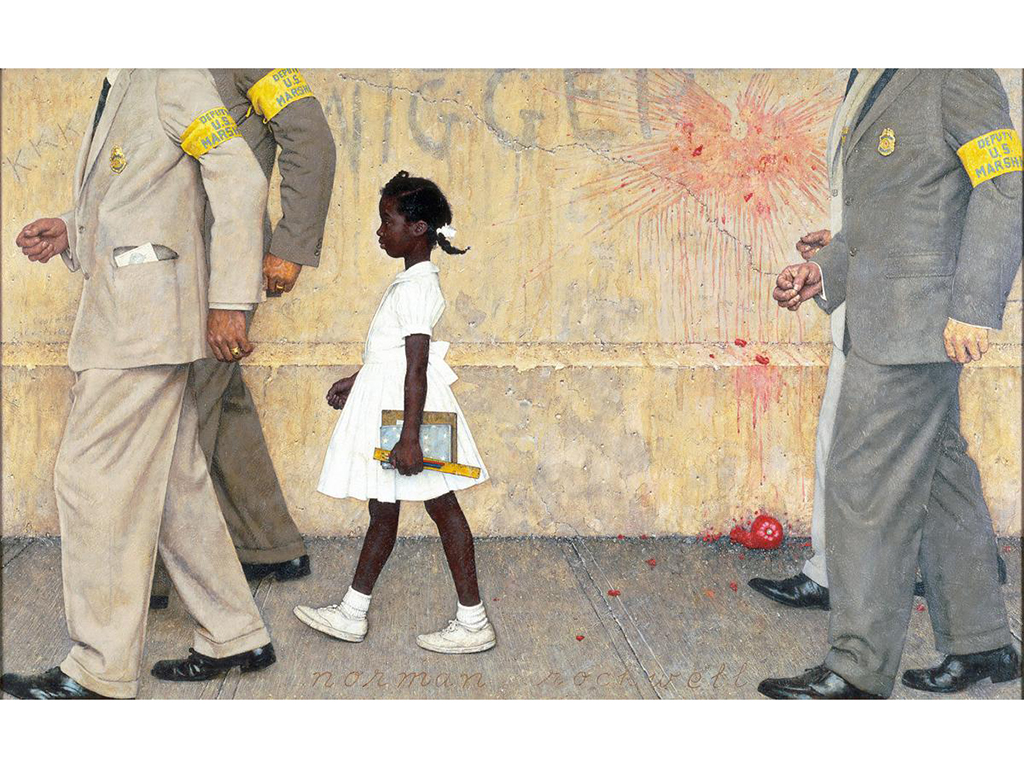
What more could you ask from a Moon Capricorn 2nd house conjunct the SN Jupiter! Moon rules the public; in Capricorn it shows his need to represent the everyday life he sees around him – hence illustration, representing what he saw in a ‘real’ way; 2nd house equates with Taurean appreciation of the arts that he made a living from; and conjunct the south node of Jupiter shows that he drew inspiration for his work from everyday American culture.
Claude Bernard – Moon Capricorn 6th conjunct SN Jupiter

French physician and physiologist Claude Bernard was attributed with noted discoveries in the functions of the pancreas and liver – both ruled by Jupiter. His significant contribution to medical science on the autonomic nervous system led to a new understanding of how an organism’s system maintains a state of balance. Could his suitably named ‘Homeostasis’ (standing still, staying the same, keeping stability) be attributed to the 6th house Capricorn Moon?
“the tendency towards a relatively stable equilibrium between interdependent elements, especially as maintained by physiological processes.”
His contribution to the collective pool of knowledge, remains something that affects us all and continues to save lives today.
It was common practice to experiment on animals at that time and the passionate anti-vivisectionist and spiritualist physician Anna Kingsford claims to have killed Bernard with her “spiritual thunderbolts (SN Jupiter) for torturing and baking animals to death.”
Karl Abraham – Moon Capricorn 12th conjunct SN Jupiter & SN Pluto
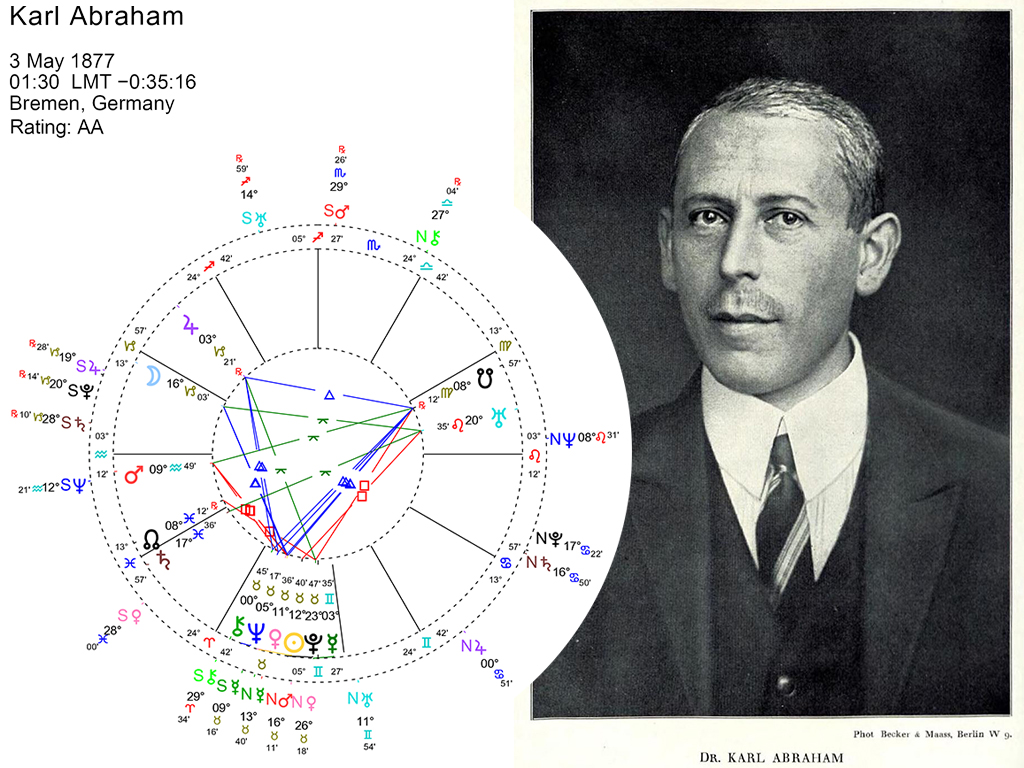
Another Capricorn Moon in the 12th, yet a world apart from Alfred Tirpitz, Karl Abraham was a key figure in the development of early psychoanalysis and a contemporary of Sigmund Freud. Abraham collaborated with Freud on the understanding of manic-depressive illness, leading to Freud’s Saturnian themed 1917 paper on ‘Mourning and Melancholia.’ His heavily tenanted Taurus third house consisting of Chiron, Neptune, Venus, Sun, Pluto and Mercury square to his natal nodes of the Moon is enough to suggest his principle theories around the role of infant sexuality in character development and mental illness, but his Capricorn Moon in the 12th house says much about his sensitivity to underlying social and cultural currents and to a remarkable understanding of presenting issues whose roots lie in the psychological depth of the unconscious.
Abraham’s cultural interests extended to the analysis of various myths where he suggested their relation to dreams (1909), all perfect symbolism for the Moon placement conjunct SN Jupiter, going so far as to write an interpretation of the spiritual activities of the Egyptian monotheistic Pharaoh, Amenhotep IV (1912).
Ernest Hemingway – Moon Capricorn 5th conjunct SN Jupiter
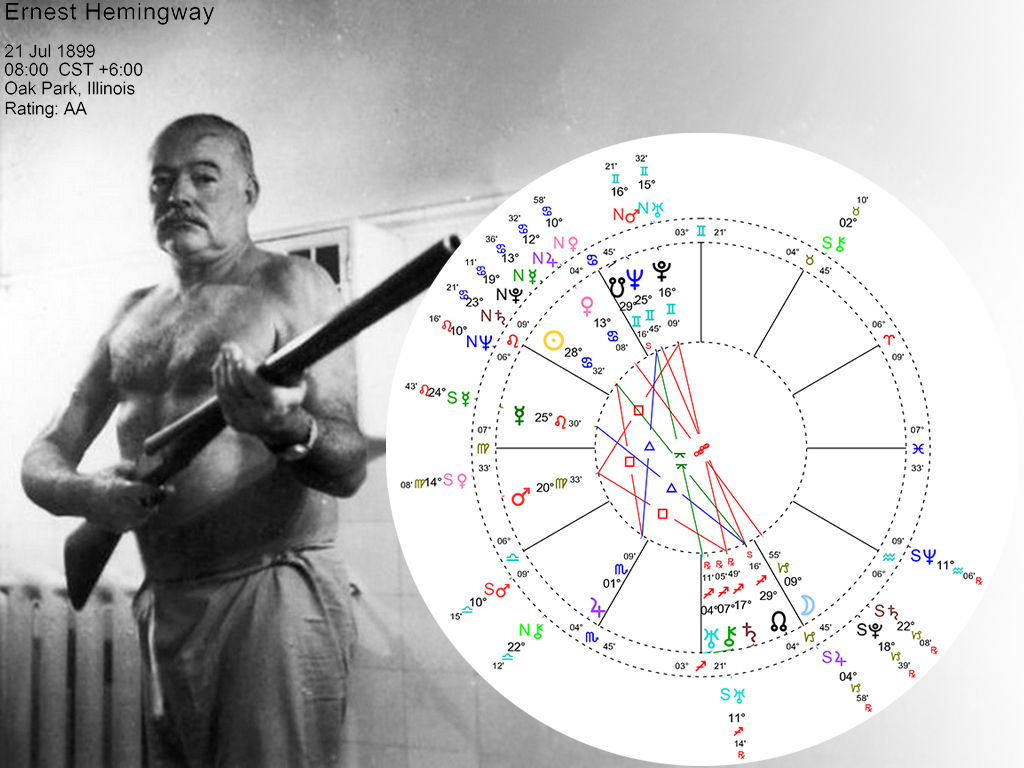
If ever there was a writer, thrifty with his words, simple, direct, and unadorned, it was Ernest Hemingway. Praised for his “forceful and style-making mastery of the art of modern narration,” his realistic dialogue was accomplished through calculated emphasis and repetition, all very suitable examples of a Capricorn Moon in the 5th house. As restrained as his writing style was, he was a man of extremes. This aspect conjunct the Capricorn south node of Jupiter emphasises the overtly collective machismo themes that drove him and that appear repeatedly in his life and work – in addition to the potential extremes of Pluto square Mars opposite Saturn, whilst conjunct the NN of Uranus and Mars!
“This spare, carefully honed and polished writing style of Hemingway was by no means spontaneous. When he worked as a journalist, he learned to report facts crisply and succinctly. He was also an obsessive revisionist. It is reported that he wrote and rewrote all, or portions, of The Old Man and the Sea more than two hundred times before he was ready to release it for publication. Mars in Virgo might have something to say about that too, especially square to Saturn and Pluto.
Hemingway took great pains with his work; he revised tirelessly. “A writer’s style,” he said, “should be direct and personal, his imagery rich and earthy, and his words simple and vigorous.” Hemingway more than fulfilled his own requirements for good writing. His words are simple and vigorous, burnished and uniquely brilliant.” https://www.cliffsnotes.com/literature/h/hemingways-short-stories/critical-essay/hemingways-writing-style
Arnold Schwarzenegger – Moon Capricorn 6th conjunct SN Jupiter
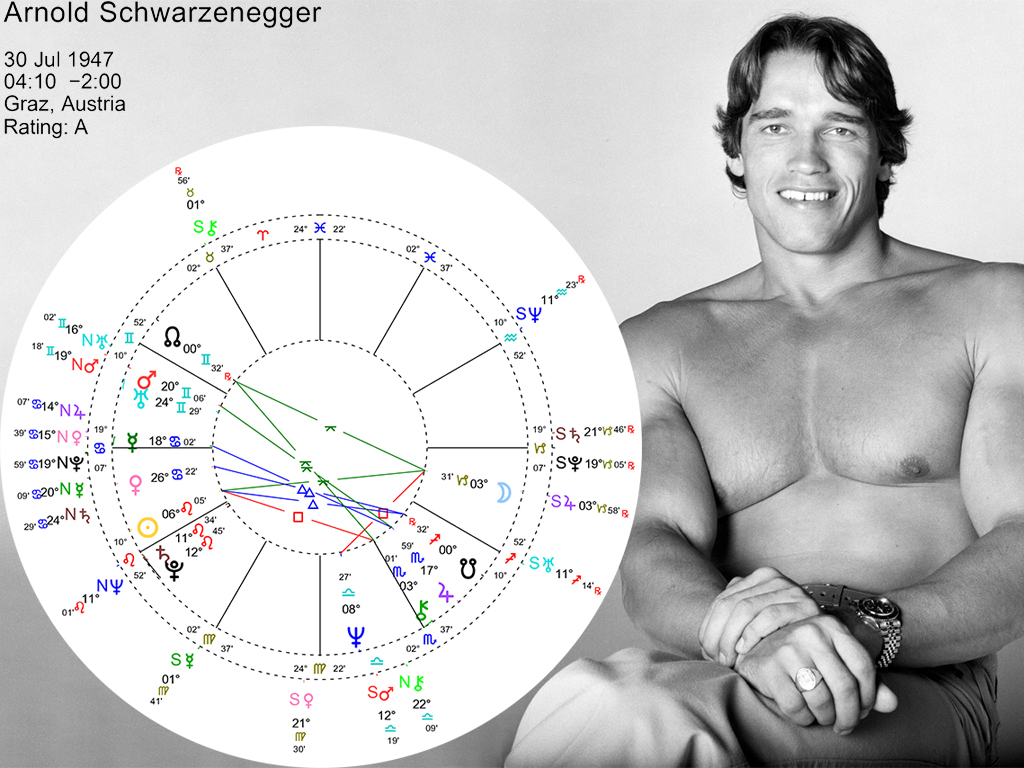
Another man influenced by the collective machismo ideal, Arnold Schwarzenegger’s Capricorn Moon in the 6th conjunction to the south node of Jupiter tells us something of his need to be the best he could possibly be and his tireless quest for the perfection of the ‘ideal’ physical form. His political aspirations speak of the Moon on SN Jupiter’s quest for prestige and influence in the earthly sphere of government, the egoic need to make an impact upon the social order and perhaps, less sceptically, a desire to use his influence to improve the lives of others.
Summary
What surprises me is the overly machismo themes: Schwarzenegger, Hemingway and Tirpitz show different aspects of this. Perhaps machismo is the wrong word – maybe self-assured, masters of their environment, with considerable powers of determination and discrimination, whether political, physical, literary, psychological or scientific.
Perhaps the influence of the south node of Jupiter allows a relative ease to their endeavours (although it’s clear that all these people have worked hard to achieve their aims), not because Jupiter might grease the gears of success but because the south node suggests a familiarity with the principles involved and being accustomed to their workings.
Another striking example that didn’t make it onto my final list was George Patton (Capricorn Moon conjunct SN Saturn and SN Pluto) – the famous belligerent American General, “a dashing, courageous, wild, and unbalanced leader, good for operations requiring thrust and push, but at a loss in any operation requiring skill and judgment.” Patton was the brash and blunt instrument used for bullying the enemy into submission.
The connection to the SN Jupiter needs to be thought about, although the pragmatic Capricorn Moon is spot on. In that regard, perhaps the overlay of Capricorn (Saturn) and Jupiter, both masculine father archetypes, emphasise the collective ideal of masculinity, of what it means to be “a man in a man’s world.” Combined with the single pointed focus of the Capricorn ego upon achievement, this lends itself well to a world-wise magician, a manifester of the real through the powers of self-determination.
Note that the only women in my database with this configuration were Stevie Nicks and Amy Winehouse – neither of whom I know enough about to be able to write with any confidence.
